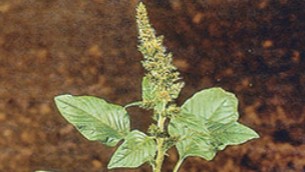Green amaranth
Refer to the link below for more detailed information on other amaranth species.

Description
The growth habit of green amaranth can be upright or spreading, so its height can vary between 40 cm and 1.5 m. The leaves of green amaranth are up to 15 cm long and alternatively arranged, often with notched tips on the end of a long stalk. The flowering stalk is made up of dense clusters of commonly green but sometimes red flowers. Like other amaranths, the fruit of the green amaranth has a wrinkled surface and contains one blackish-brown seed that is not very shiny.
Control
Betanal® Flow is registered for the control of cotyledon green amaranth in beetroot, fodder beet and silver beet. Roundup Ultra® MAX, Roundup Ready® Herbicide with Plantshield® and Roundup Ready PL are registered for the control of amaranth species in a range of situations.
References
Fleming, J, McNee, T, Cook, T and Manning, B (2012), ‘Weed control in summer crops 2102 – 2013’, NSW Department of Primary Industries, https://www.dpi.nsw.gov.au/__data/assets/pdf_file/0008/248471/Weed-control-in-summer-crops-2012-13.pdf
Herbiguide (2014), ‘Green Amaranth’, Herbiguide, http://www.herbiguide.com.au/Descriptions/hg_Green_Amaranth.htm
Hussey, B, Keighery, J, Dodd, S and Cousens, R, (2007), ‘Western Weeds: A guide to the weeds of Western Australia, 2nd Edition. The Weeds Society of WA, https://www.wswa.org.au/western_weeds/amaranthaceae.htm
Lucid Central (Viewed April 2020), ‘Amaranthus viridis’, https://keys.lucidcentral.org/demo/js_player/sew2/text/amaranthus_viridis.htm








